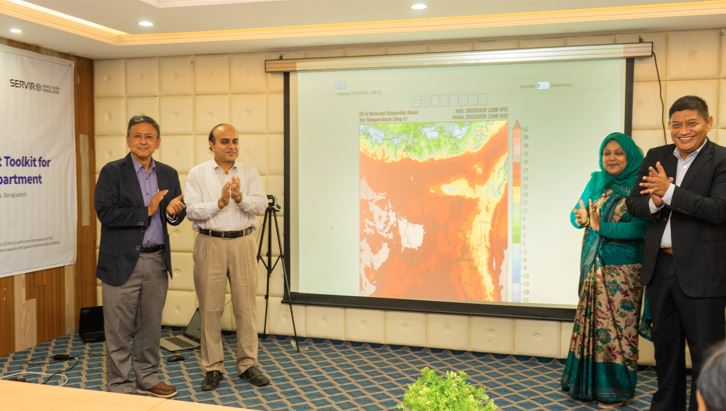
DHAKA, March 30, 2022 (BSS) - Bangladesh Meteorological Department (BMD) today introduced the High Impact Weather Assessment Toolkit (HIWAT) aiming to simulate extreme weather hazards and issue more accurate operational forecasts.
The weather assessment toolkit was launched at a meeting at the BMD headquarters in the capital.
The toolkit was introduced under the SERVIR Hindu Kush Himalaya (SERVIR-HKH) Initiative of the International Centre for Integrated Mountain Development (ICIMOD) in collaboration with the BMD, NASA SERVIR Science Coordination Office (SCO) and the NASA – Short-term Prediction Research and Transition Center (SPoRT).
The NASA SERVIR Applied Sciences Team developed the system and further customised it for Bangladesh.
The BMD has invested its own resources to install the HIWAT on its high-performance computing cluster to support its operational forecasts.
Basanta Raj Shrestha, Director of Strategic Cooperation, ICIMOD; and BMD Deputy Director ((Director-In- Charge) Kawsar Parvin jointly launched the toolkit at the event.
Birendra Bajracharya, Chief of Party – SERVIR-HKH, ICIMOD; made a presentation on “HIWAT Bangladesh – Boisakhi – and its functional aspects, while Senior Climate Adaptation and Resilience Advisor of USAID Dr Pete Epanchin and Capacity Building Programme Manager of Applied Sciences Programme at NASA Headquarters Dr Nancy Searby spoke at the meeting virtually.
On the sidelines of the launching ceremony, Birendra Bajracharya said the BMD applies multiple models from multiple parameters in weather forecasting.
The HIWAT will enhance the BMD’s capacity and support its decisions, he said, adding that the toolkit was developed by NASA and customised for Bangladesh in collaboration with the BMD.
Bajracharya said applying the high impact weather assessment toolkit, the BMD will now be able to issue forecast two days before any extreme weather event hits.
In a written speech read out by meteorologist Dr Abdul Mannan, BMD Director Md Azizur Rahman said Bangladesh is a hotspot for high-impact weather events– intense rainfall, damaging wind and hail, frequent lightning strikes, and cyclones.
“In Bangladesh, we are all aware of Kal Baishakhi– localised rainfall and thunderstorm events often exceeding 100 km hours that hit us between April and May every year,” he said.
He added: “Every monsoon, incessant rainfall causes continued flooding in large swathes affecting thousands across our country. In the past two years alone, we have been hit by cyclones Yaas, and Amphan causing massive damage to our coastal areas.”
Azizur said the impacts of high-impact weather events on lives and livelihoods are dire, while these events will be more frequent and more intense in the future.
He said the HIWAT is a service that provides probabilistic-based thunderstorm hazard forecast guidance to forecasters and other weather-sensitive decision-makers.
“It provides outlooks for lightning strikes, high impact winds, high rainfall rates, hail, and other weather events. With HIWAT installed on our HPC system, we are now able to operationalize ensemble model forecasts to enhance our weather forecasting capabilities,” he added.
At the meeting, meteorologist Dr Abdul Mannan made a power-point presentation on the BMD’s weather and climate forecast systems.